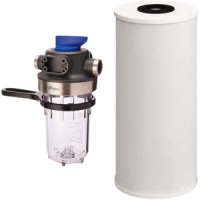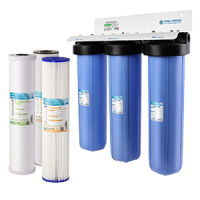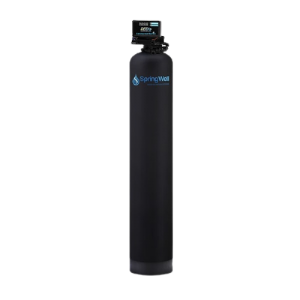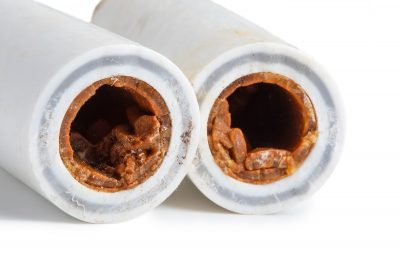- Iron contamination in US wells is very common and causes a bunch of issues, from brown water and appliance stains to metallic tastes.
- When improperly treated, iron-rich water can also become a breeding ground for bacteria.
- Unfortunately, many people try to remove iron using cartridge or carbon water filters, which aren’t effective on well water.
- This is because there are several types of iron contamination, and most iron needs to be oxidized before it can be filtered.
- To oxidize and remove iron from well water, use an injection filter system.

To effectively remove iron from well water, you need to know what types of iron you’re dealing with. Then, you need to choose the right filtration system for your needs.
💡 Our favorite injection filter system for iron removal is the Pentair WF4-P
What types of iron are in my well water?
In general, wells can be contaminated with three different types of iron. Finding one type of iron in your well water means that other types of iron are more likely to be present.
Iron contamination is often visible to homeowners in the form of staining or clouding, so you may already know what type of iron you’re dealing with.
However, the most accurate method of identifying iron in drinking water is to perform a well water test.
Ferric iron (red water iron)
Water that’s cloudy, brown, or orange is likely to contain ferric iron. This undissolved type of iron is often referred to as rust and forms when the metal is exposed to water and the air.
Undissolved iron mixes with groundwater to create discoloration and metallic tastes. You can often see this water browning most clearly in areas of your plumbing where water collects, such as the top of your toilet.

Ferrous iron (clear water iron)
Ferrous iron is the scientific name for dissolved iron that’s not detectable by sight.
While it may give off a noticeable odor and taste at high levels, the biggest effect of dissolved iron is staining to bathroom fixtures, kitchen appliances, and anything else that regularly comes into contact with your water supply.
As dissolved iron comes into contact with the air, it can also become ferric iron and contribute to water discoloration.

Iron bacteria
When well water contains high levels of iron, it can harbor bacteria that use the metal for their energy production.
As their numbers increase, iron bacteria produces a red or orange slimey film that can quickly overtake a plumbing system. This creates clogging that affects the performance of appliances and encourages water stagnation.
So, while iron bacteria isn’t a health risk in itself, it can cause extensive damage.

Why won’t my cartridge filter work on iron?
The vast majority of water filtration systems found in homes across the US contain a type of filter media called granular activated carbon (GAC).
If you currently own a water filter system, it probably uses granular activated carbon.
While these filters cover a wide range of contaminants and greatly improve the taste and smell of drinking water, there are certain things they can’t do.
Simply put, common GAC filters are not designed to capture iron.
Undissolved iron particles quickly clog up GAC filters, while dissolved iron passes straight through them.

This is because GAC filters don’t oxidize contaminants. Oxidization is the process used to turn dissolved metals like iron into an insoluble form that can be removed by a filtration media.
Without an oxidizing stage, no water filter can remove iron in any significant amount.
What about my sediment cartridge filter?
Another type of cartridge filter that people commonly use when trying to tackle iron contamination is a micron filter or sediment filter.
By passing water through fine mesh screens, these devices filter out tiny particles of iron or rust from the water supply.
If you’re currently using a sediment filter to address your iron issues, you’ve probably noticed the replaceable filter screen quickly turning orange or brown as it captures contaminants.

Undissolved iron collecting on a sediment filter cartridge
Sediment filters can do a good job of removing undissolved iron from the water supply. However, when used without an oxidization stage, they can’t remove dissolved iron.
As this dissolved iron moves through your plumbing system, it still creates contamination issues.
So, while sediment filters are useful for removing undissolved iron particles, they’re not very effective when used alone.
 If you’re certain that undissolved iron is the only major type of iron contamination in your well, we recommend the Culligan WH-HD200 for small particulate matter.
If you’re certain that undissolved iron is the only major type of iron contamination in your well, we recommend the Culligan WH-HD200 for small particulate matter.
It’s one of the most well-reviewed sediment filters online, and is compatible with a range of different micron screens, meaning that you can target specific contaminants.
What about my KDF (Kinetic Degradation Fluxion) cartridge filter?
KDF filters are a less common, but still popular, type of home cartridge water filter. They work by using a combination of metals like copper and zinc, which act as a catalyst in water.
Because KDF filters do oxidize contaminants, they are able to remove both dissolved and undissolved iron from well water.
However, their performance and lifespan are normally much lower than injection filter systems.
If you choose a KDF cartridge filter that’s not rated to handle the levels of iron in your well water, then you’ll be left with some iron content in your water post-filtration.
This might not be an issue from a water quality standpoint, but even low levels of iron in water can lead to iron bacteria growth.

If your well water contains low levels of iron and you’re looking for an inexpensive cartridge filter to fix the issue, we recommend this 3-stage KDF system from APEC Water.
As the winner of our “Best under $500” category in our 2022 Best Well Water Filtration Systems review, we think the APEC filter offers a decent compromise of price and filtering power.
How to effectively reduce iron in well water
Chlorine injection filtration systems
We recommend: Pentair WF4-P.
The best way to remove iron from well water is to use a chemical injection filtration system. These products contain an automated feed pump that injects small amounts of disinfectant chemicals (usually chlorine) into the water supply.
Adding chlorine to water starts an oxidization process, which draws out dissolved iron and converts it into an insoluble form. By holding the chlorinated water inside a tank, chemical injection filters also reduce the risk of iron bacteria growth.
Once oxidized, injection filters pass water through a greensand filter media, which removes large amounts of insoluble iron. This makes them amongst the most powerful iron filters available.

We recommend the Pentair WF4-P for anyone considering a chlorine injection filtration system. In our review of the Best Iron Filters for Well Water, it removed the most dissolved iron of any filter—and was the only system to remove all three types of iron contamination without the need for any additional products.
Because the WF4-P contains a sediment micron filter to screen out undissolved iron, and uses a bacteria-inhibiting chlorine oxidization process to remove dissolved iron, it’s a complete solution for iron-rich well water .
Air injection filtration systems
We recommend: SpringWell WS1.
Also known as air-oxidizing filters, these devices work in a similar way to the chemical injection filters above.
By introducing a pocket of air into the tank of the filter system, they cause ferrous iron to naturally oxidize into an insoluble form without the use of chemicals. The insoluble iron can then be filtered from the supply.
If you’re interested in air injection filters, we recommend the SpringWell WS1. This system won the “Best Overall” spot in our 2022 Well Water Filter review, thanks to impressive performance, maintenance-free running, and reasonable price.

Beware! When using an air injection system on water with high levels of iron contamination, be careful about potential iron bacteria growth:
- While air injection filters effectively remove iron, air pockets introduced into water may promote the growth of iron bacteria if the filter system is not correctly rated for your water profile.
- If you do use an air injection filter on water with extreme iron levels, make sure you take additional steps to protect your plumbing from bacteria, such as installing a UV purifier.
Chlorine disinfection (shock chlorination)
If iron bacteria is the only major type of contamination in your well, you can treat it by periodically flushing your system through with a disinfectant chemical like chlorine.
Often carried out by professionals and referred to as shock chlorination, this method involves introducing a large amount of chlorine throughout the well system to remove bacteria.
If chlorination becomes a regular part of a water treatment routine, homeowners often also choose to install an activated carbon filter, which helps to reduce any residual chemical taste or smell.
Chlorination for iron bacteria is effective, but it’s rarely a permanent solution. The bacteria-free period after chlorination tends to last between a few months and a year.
Extra: Other reasons for brown well water
Iron is an extremely common cause of discolored well water, especially if the color is a reddish or orange brown.
But there are a few other possible reasons behind a cloudy or brown tap supply. Here are some sources of brown well water:
Pipe rust
Most rust is ferric iron by another name. When iron oxidizes and is exposed to water, rust is the result. Most of the time, the presence of rust indicates corrosion in piping, so this contamination may not come from your well.
Tannins
When soil and leaves decay they can produce tannins. Tannins create a muddy red color that can be seen in tea leaves and wine—as well as groundwater. Tannins often produce a tangy taste and aren’t considered a health risk.
Silt & sand
Fine sand and mud particles can leak through well casings and be drawn into the well pump. Silt and sediments can make water cloudy and murky. In some cases, silt in water may also indicate the presence of coliform bacteria.
Whenever water is discolored, one thing to note is the possibility of corroded pipes and plumbing fixtures.
Solving for iron-contaminated well water is not a fix for rusty plumbing, as the water supply will pick up rust particles after water passes through any filtration stages.
If you’re experiencing rust-colored water and live in an older house or cannot accurately date your plumbing, it’s worth having your system checked by a professional—especially if the above filtration methods don’t significantly improve your water quality.

